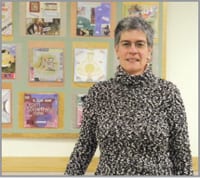An Answer to the Pain – Women Need to Know the Facts About Endometriosis
It’s a condition that affects one in 10 women at some point during their reproductive years, putting many at risk of infertility — a condition that celebrities ranging from Padma Lakshmi and Lena Dunham to Jillian Michaels and Julianne Hough have struggled with and spoken openly about.
Yet, it’s also a condition that many women seeking infertility treatment may not even know they have, said Dr. Halina Wiczyk, a reproductive endocrinologist at Baystate Medical Center.
“Endometriosis is a very common finding in women seeking infertility treatment,” Wiczyk said, noting that this often-debilitating condition affects some 5 million American women at any given time.
However, although a large percentage of women suffer from the disease, the lack of awareness about endometriosis often causes a delay in seeking treatment. It can take up to 10 years for a woman to be accurately diagnosed, and some, lacking symptoms, go undiagnosed.
“The greater length of time to diagnosis, especially in younger women, is due to the fact that, initially, endometriosis may not be thought to be the cause of painful periods that the patient is complaining of,” she said. “So a definitive diagnosis is not made at that time, sometimes until much later.”
Endometriosis is a condition in which tissue similar to the lining inside the uterus is found outside the uterus, where it induces a chronic inflammatory reaction that may result in scar tissue. Symptoms, which can start as early as a girl’s first period, may include painful periods, painful ovulation, pain during or after sexual intercourse, heavy bleeding, chronic pelvic pain, fatigue, and infertility.
Dancer, singer, and actress Julianne Hough told Glamour last year of her struggles to discover had been causing her pain since adolescence.
“For the longest time, I thought, this is the way my period is,” she recalled. “I didn’t want to complain, so I’d just deal with it and ignore it.” When she was 18, she moved in with a roommate who’d been diagnosed with the condition and described her symptoms, which sounded familiar. Hough found a doctor who eventually diagnosed her with ‘endo,’ as it’s colloquially known.
While there is no one specific cause of endometriosis, Wiczyk said doctors do know that genetics and environmental factors can play a role, as well as family history, age, non-suppression of menstruation, and various uterine abnormalities.
The most common symptom of endometriosis is pelvic pain, which often correlates with the menstrual cycle. The pain can be so severe and debilitating that it impacts women significantly, interrupting their daily schedules. Other symptoms include fatigue, painful intercourse, painful urination during periods, painful bowel movements during periods, excessive bleeding, and other gastrointestinal problems.
Inspired to Reach Out
Author, model, and television host Padma Lakshmi said endometriosis effectively exiled her from her life one week a month for more than 20 years. As she notes, she was a college-educated, professional woman living in a major city with access to the best doctors and health insurance, yet she had never heard of the disease.
Once diagnosed, she writes, “I wanted to change that for other young women,” so, in 2009, she founded the Endometriosis Foundation of America with her physician, Dr. Tamer Seckin. ‘Endofound,’ as it’s also called, is a nonprofit organization dedicated to combating endometriosis through advocacy, targeted research, education, and increasing awareness.
“Personally and spiritually, Endofound has been incredibly rewarding because it gave purpose and meaning for what would have otherwise been completely unnecessary suffering,” Lakshmi explains on the foundation’s website.
For sufferers looking for a diagnosis, a pelvic exam performed by a doctor is the first step to acknowledging a potential problem, Wiczyk said, adding that an especially reliable way to diagnose endometriosis is by a surgical procedure called a laparoscopy. During the procedure, a lighted, thin tube connected to a camera is inserted into the abdomen through a small incision, allowing doctors to view the abdominal cavity — including such areas as the outside of the uterus, ovaries, fallopian tubes, and other nearby organs — and actually see the areas affected by endometriosis and treat and/or remove them. Ultrasound can also be used to evaluate the pelvis. Other treatments, in addition to surgery, include pain medications and hormone therapy.
Unfortunately, she noted, there is no cure for endometriosis, with treatment options only alleviating symptoms and helping patients to return to their daily lives. Management of the disease is often a long-term process, and if one treatment doesn’t work, she said, it is important to remain optimistic and work with one’s doctor to explore other options.
“Among those options are less-invasive surgical techniques, such as alcohol ablation, which is especially effective in treating what we refer to as ‘big chocolate cysts’ resulting from the endometriosis,” Wiczyk said. “It is also important to note that assisted reproductive technologies, available at Baystate, may be necessary to help women with endometriosis become pregnant.”
According to the World Endometriosis Society, pregnancy may relieve symptoms, but is not a cure for the disease. Hysterectomy, with surgical removal of all the disease at the same time, may relieve symptoms, but may not be a definitive cure, either. Removal of the ovaries at the same time as a hysterectomy is performed increases the chances of pain relief but also results in an immediate menopause.
While there is no known cause of endometriosis, it is highly likely that certain genes predispose women to develop the disease. Thus, women have a higher risk of developing endometriosis if their mother and/or sister are also affected. It is possible that age when the menstrual period starts, other gynecologic factors, and environmental exposures influence whether a woman is affected.
Some studies have linked the presence of endometriosis with the development of ovarian cancer; however, the association is not definitive, and the absolute risk for a given woman with endometriosis is exceedingly low, the society notes. Whereas endometriosis cells have been localised adjacent to ovarian cancer cells, the former has not been proven to be a precursor to cancer.
Seeking Solutions
Yet, the classic association with endometriosis is infertility. Most patients with infertility are now laparoscoped, specifically to look for evidence of tubal damage and to check for endometriosis.
Gynecologists say the incidence of endometriosis is increasing as more patients defer their childbearing. Therefore, young women under the age of 40 who present with infertility or abnormal gynecological symptoms, such as pain, bleeding, or painful intercourse need active investigation to exclude the possibility of developing endometriosis.
As Hough noted, education and communication are key.
“I realized how important it was for me to be open and bring awareness,” she said. “I got a floodgate of comments and followers — people were coming together and supporting each other. I feel really great abut that. It gives me a reason to keep being open.”




Comments are closed.